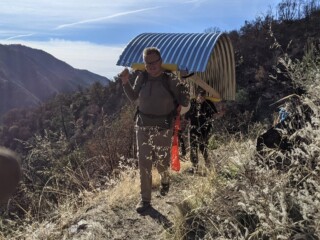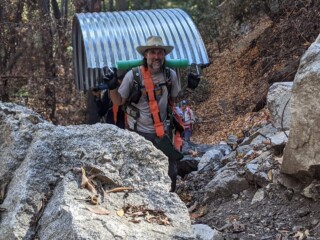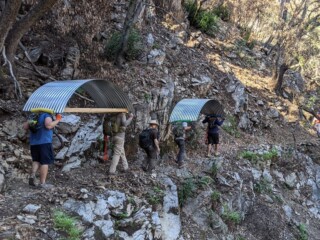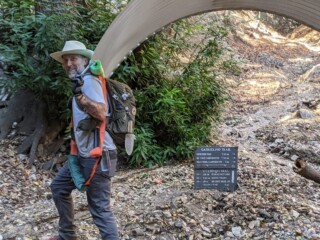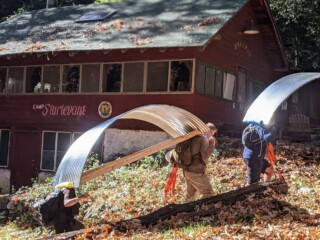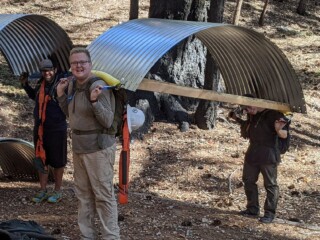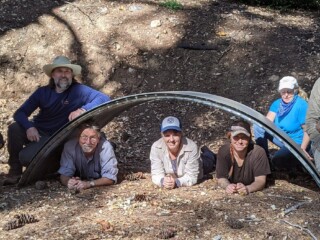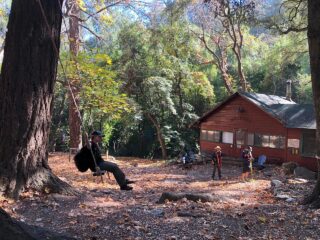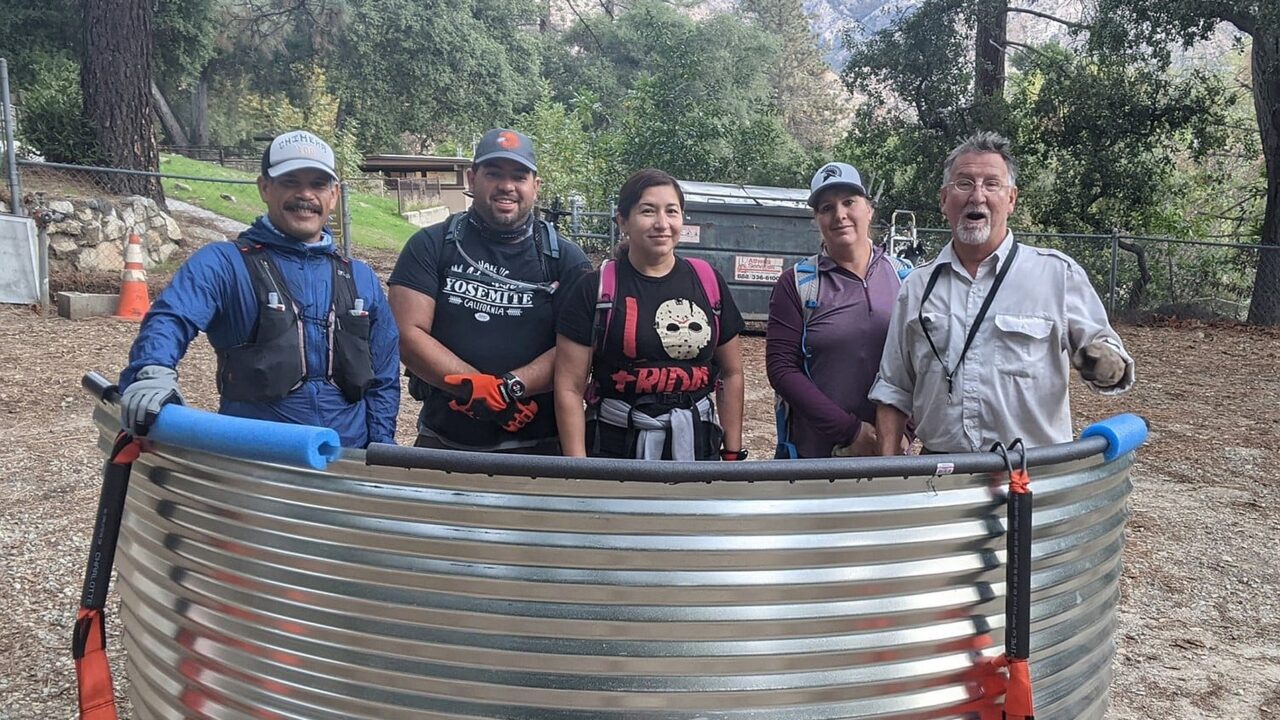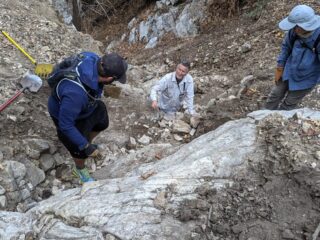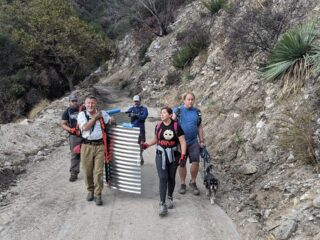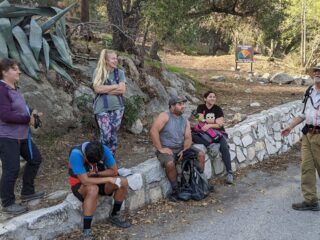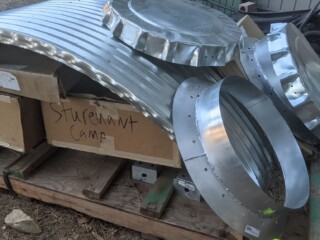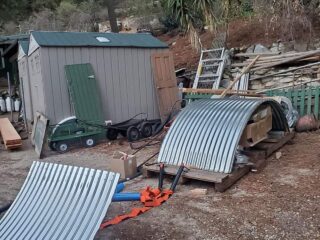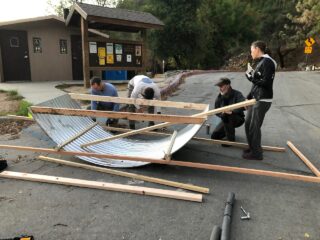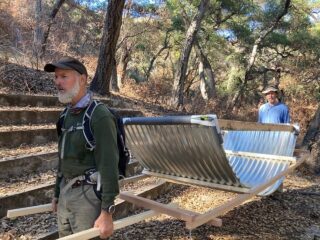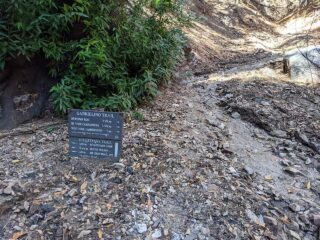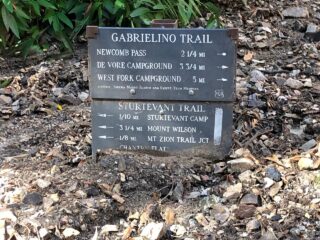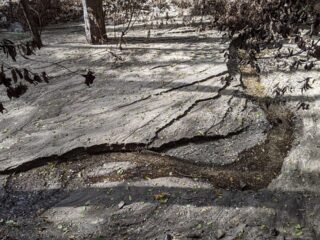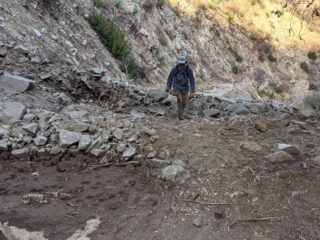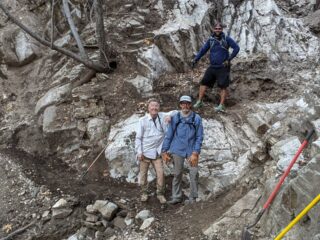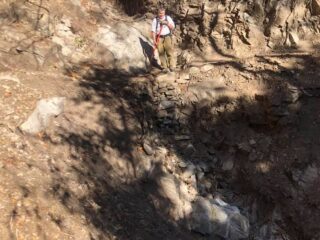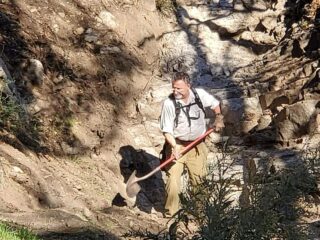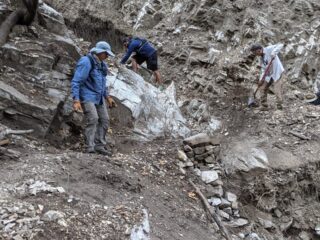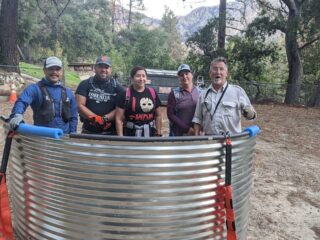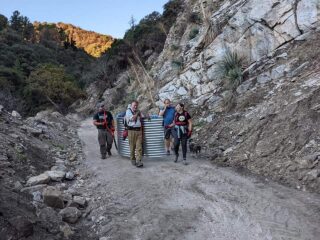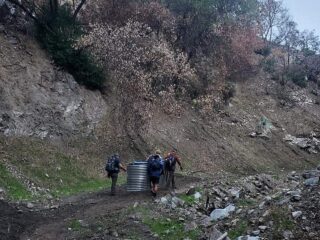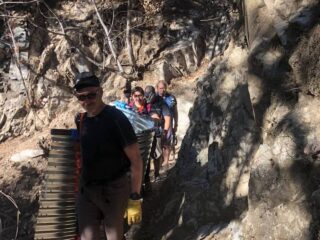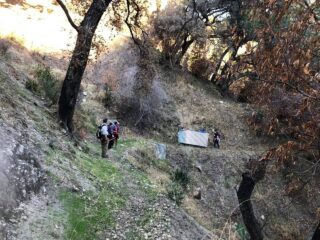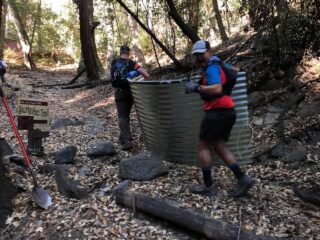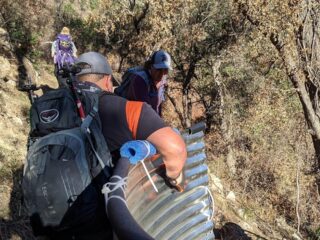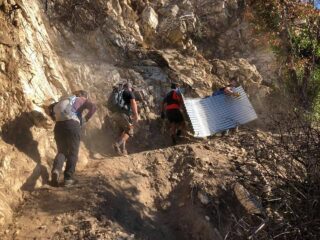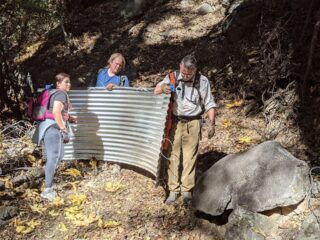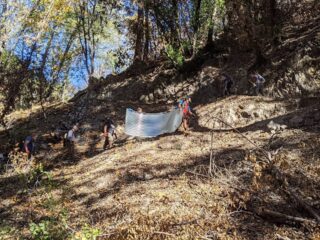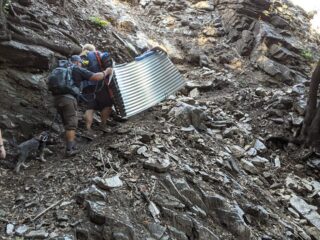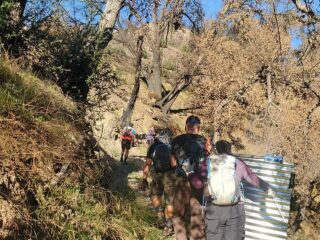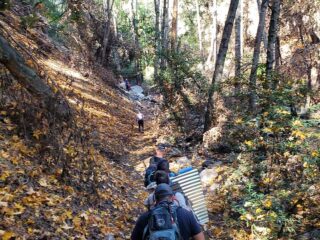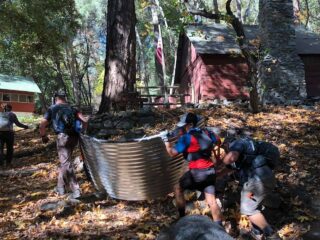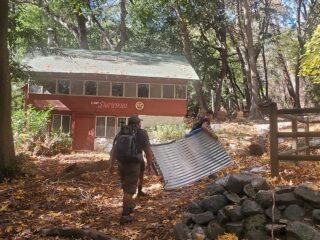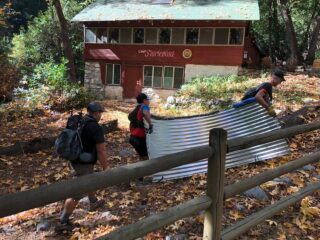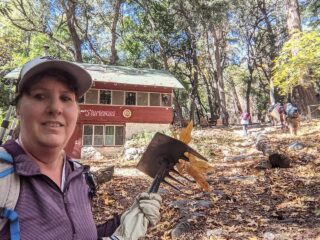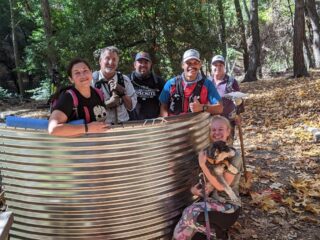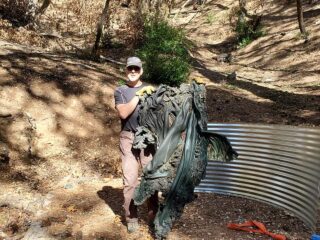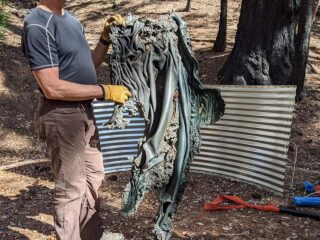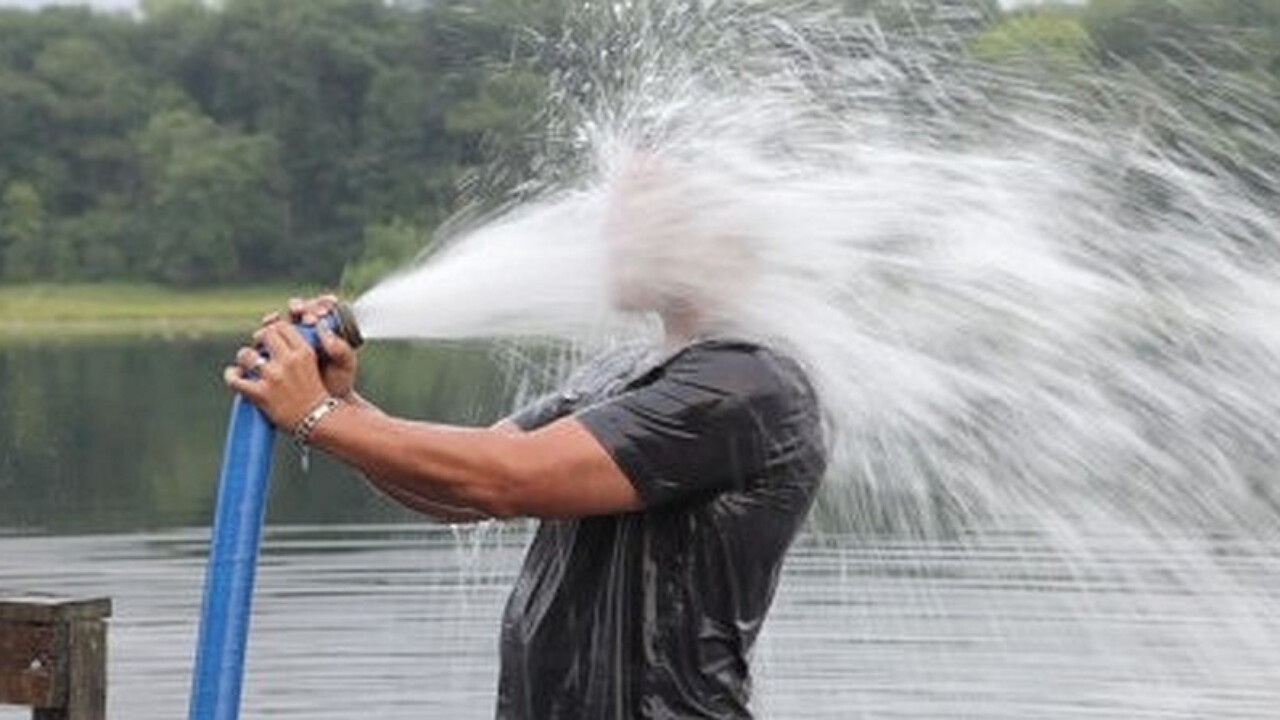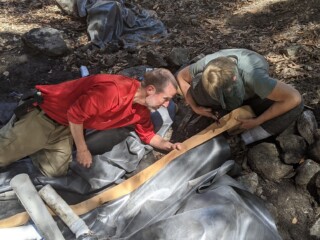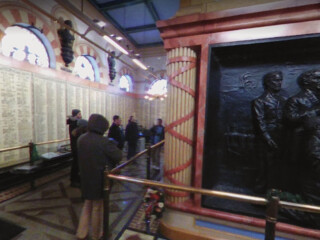Trails of the Big Santa Anita Canyon are once again alive with the sounds of happy hikers, and the Camp’s Big Swing is back in action. Here’s good news, sad news, and a look ahead into 2025.
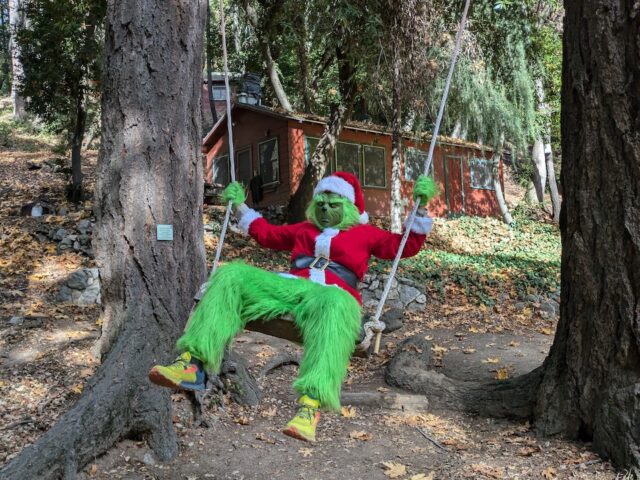
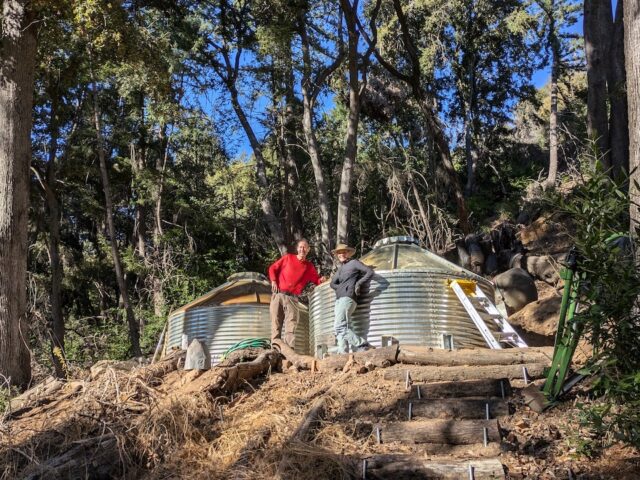
Doused & Dedicated
Fifty months after the Bobcat Fire burned and melted two of the Camp’s old water tanks, representative donors, volunteers and members of the Conservancy’s Board gathered in Camp December 7th to dedicate two replacement water tanks. Those present were given a blue-ribbon necklace with a steel nut and washer from the steel tank assembly— blue for water, and for ‘winning’ the Quench fundraising campaign and construction of the new water system.
A photo display in the Lodge illustrated the immediate aftermath of the fire, volunteers reclaiming the pack trail to Camp, then hand-carrying the tank panels up to Camp, followed by forming the foundations, assembling the tanks and testing amidst several setbacks.
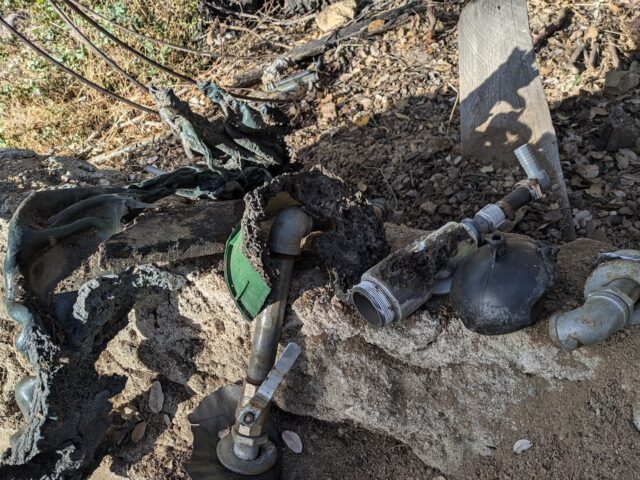
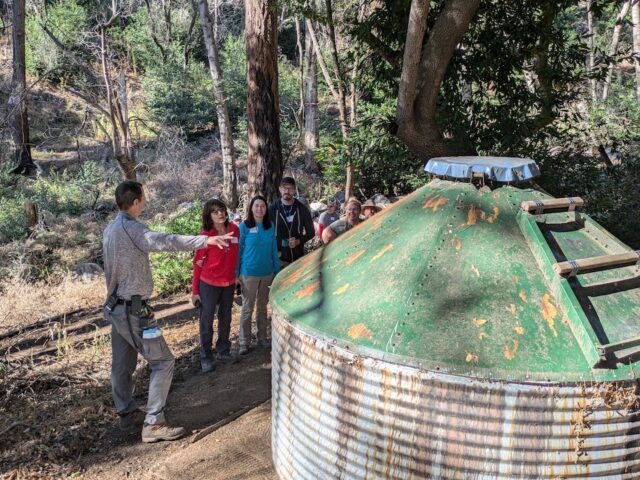
Gathering everyone at the public water fountain, Site/Ops and Quench project Manager Paul Witman then led the group on a hike to the top of the water system at survivor Tank-1, describing the water system along the way. Next, everyone clustered around the new tanks for a bit more storytelling, and Directors from the Board then took turns reading the names of all the financial donors.
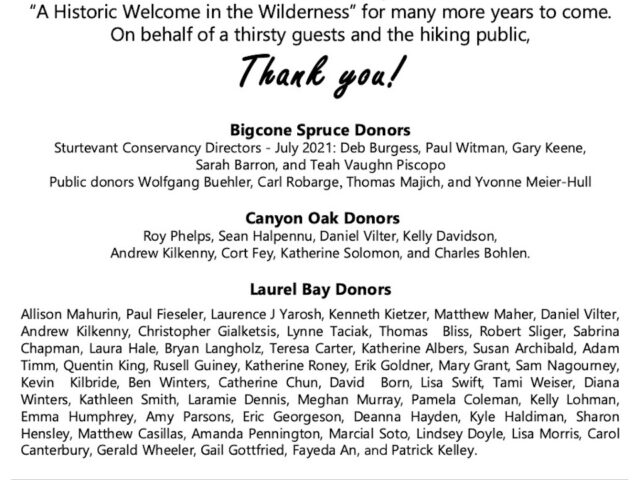
With cups of water drawn directly from the new in-flow pipe, and an exchange of thank-yous, everyone doused the tanks. Heading down into Camp, people stopped at the dedication plaque, then returned to the main Lodge.
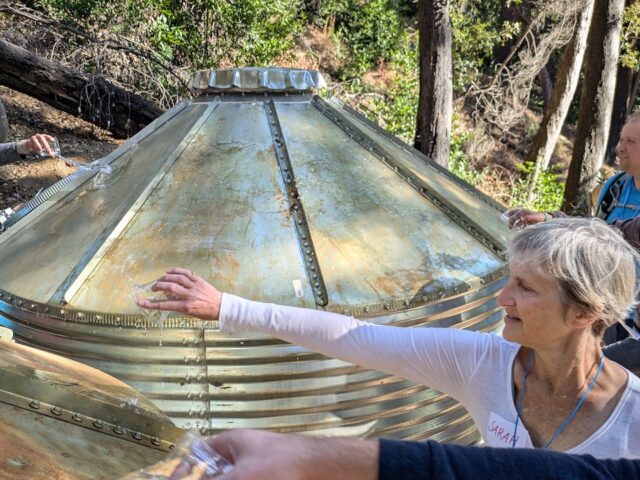
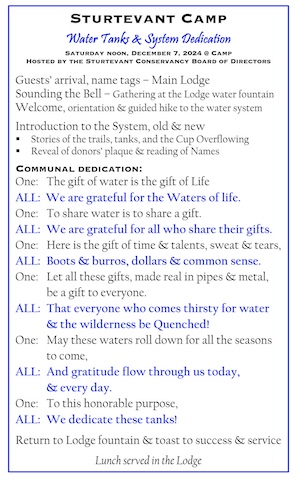
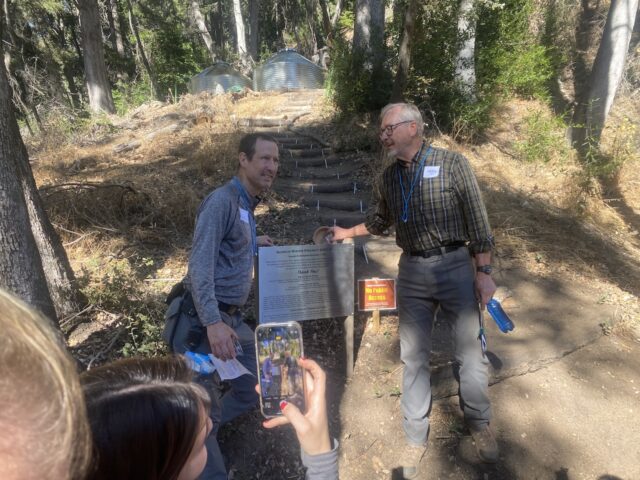
Gathered once again at the water fountain at the Lodge, the bottom of the delivery system, everyone filled their cups one more time for a toast to the success of the project, and to Paul Witman: President Gary Keene presented him the ‘Silver Spudger Award’ and invited all to join in declaring the project “to be known henceforth as the Witman Water Works!”
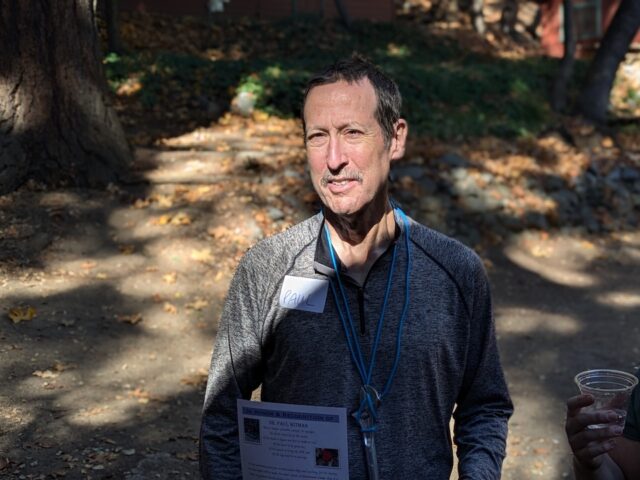
A served luncheon followed in the historic Lodge, and the volunteers present who had worked the trails and carried the tank panels were given a custom “Sisyphus” t-shirt as recognition of their persistent efforts.
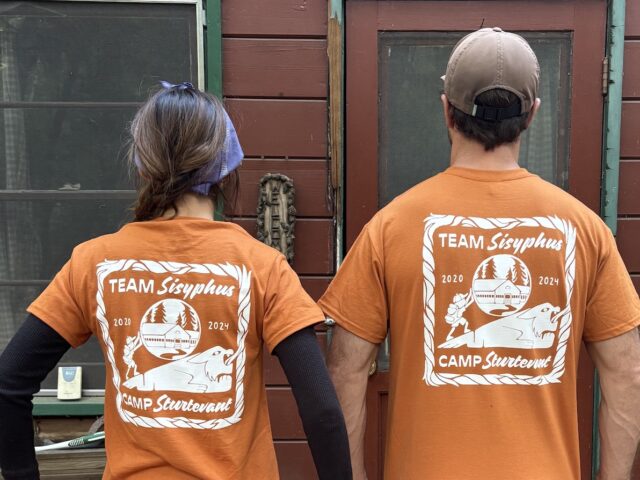
In an appropriate twist of fate, as guests headed down the Canyon, Paul led volunteer Robert Morozco and fellow Board member Kelly Davidson back up to the new tanks, where they dug out a section of the plumbing to add in one more pipe that was mistakenly left out of the system—proof that the work at Camp never really ends!
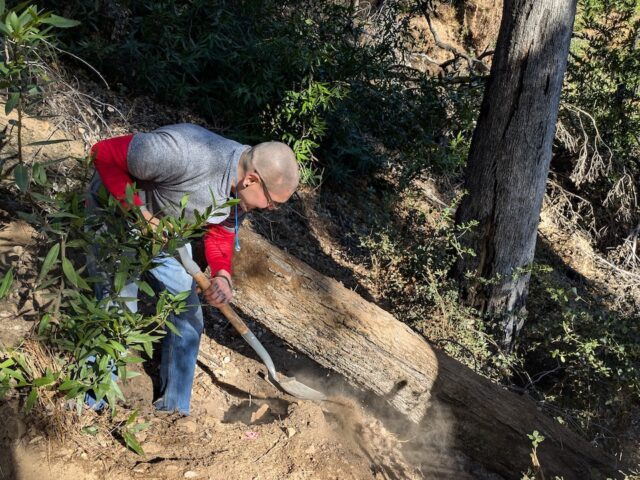
Thank you to everyone for making the vision of ‘potable water in the wilderness for all’ a reality!
Mortals in the Mountains
In the last newsletter posted here, the search for a hiker lost for several weeks was underway. What is now considered to be a recovery effort remains an unsolved mystery—and has been supplanted by more tragic news: a trio of hikers recently breeched the closure signs near Hermit Falls in the lower canyon, and the lead hiker fell to his death.
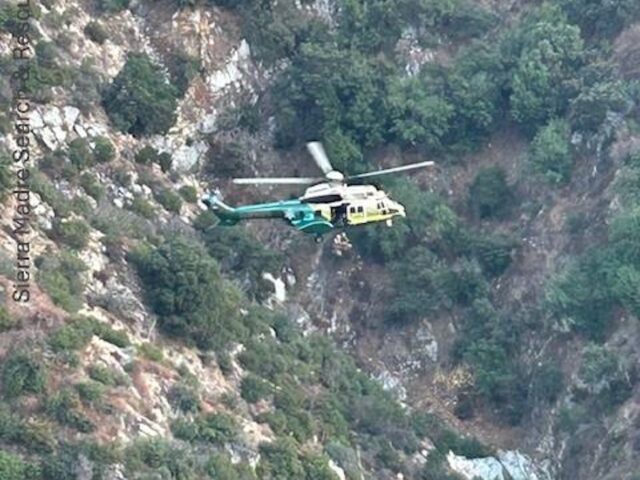
Brent Pepper, a Director on the Conservancy Board, and Patrick Kelley, a patrol agent for the Cabin Permitees’ Association, were the first two responders. Their contact and location info were critical to guiding the County Sheriff’s helicopter to the rescue site. Also, fellow Board member Teah Vaughn was working at Adams Pack Station, which became the hub of the response process, and she too became key to communications as well as care for the deceased hiker’s companions.
It was rough for everyone, and a hard reminder that much as we love the wilderness, it remains a wilderness, a risky place that demands respect on its own terms. Come and visit, but hike safe!
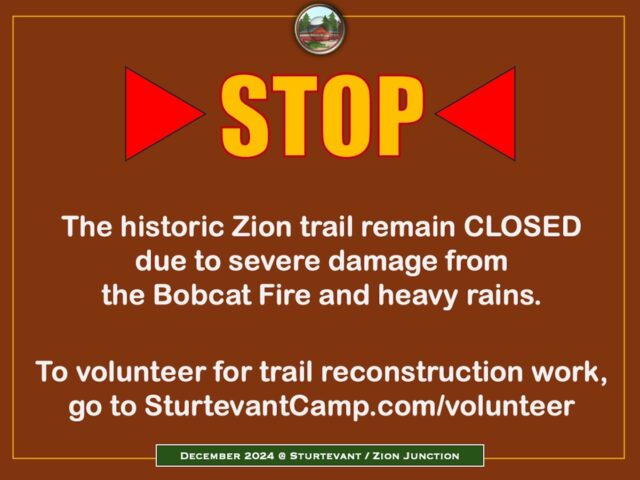
Trail Update
Soon after the Canyon opened, it was clear that many hikers come up to Camp with the goal of hiking one of the three connecting trails to make a big, beautiful loop through the mountains: up and over Mt. Zion, or Mt. Wilson, or to Newcomb’s Pass and beyond. In early October, all of those trails remained closed and impassable, and many U-turned at Camp, disappointed.
The good news is that as of Dec.1st, the original Sturtevant Trail between Camp and Mt. Wilson is now open. Thanks to the combined efforts of Sturtevant volunteers, the LoweLife’s trail crew, and especially the San Gabriel Mountains Trailbuilders who worked the trail from top to bottom, this challenging trail is now passable (with more finishing work yet to come.)

Work is now scheduled to tackle the Gabrielino Trail between Newcomb’s Pass and the Camp, and various groups are working both sides of the Mt. Zion trail between Camp and Hoegees/Winter Creek. Weather and the steady persistence of the volunteer crews will determine how rapidly the work progresses. Given the success to date, either or both trails could be cleared by early spring. To volunteer, click here.
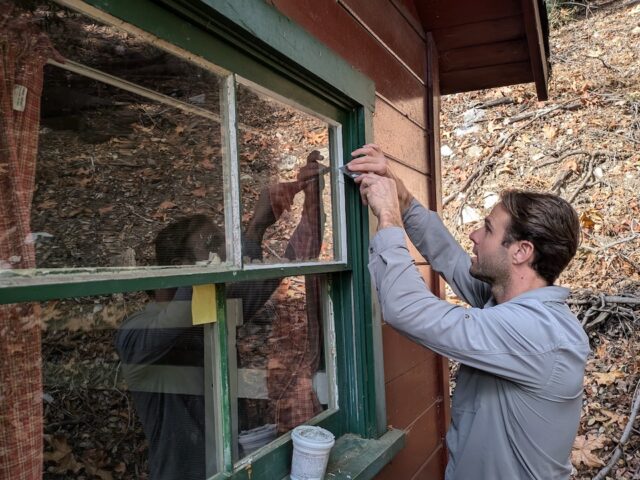
2025 Camp Projects Countdown
Since October 5th, the Camp has been open daily to hikers each Saturday and Sunday. In January 2025, guests will finally be welcomed to stay overnight, starting with a Scout troop on MLK weekend. Between now and then, plenty of work remains to prep the cabins and facilities for paying guests.
Some of that will be a final deep cleaning after four years of closure, some of it checking appliances (water heaters, refrigerators), and finally repair to the bear damage that has recurred since the Fire and shutdown.
Other deferred maintenance is on the list, and public-invite workdays will be posted to Wilbur’s Facebook page and by email for everyone who wants to join in bringing the Camp to its best condition. To get on the email list, sign up here.
The Biggest Project
The biggest project isn’t housekeeping, it’s hospitality: we’re building a new team of Hosts! If you’re interested in volunteering, contact Guest & Hospitality Manager Teah Vaughn for a job description, application and info on upcoming training dates (hostmanager@sturtevantcamp.com). It’s the best way to be in Camp and make a big difference!
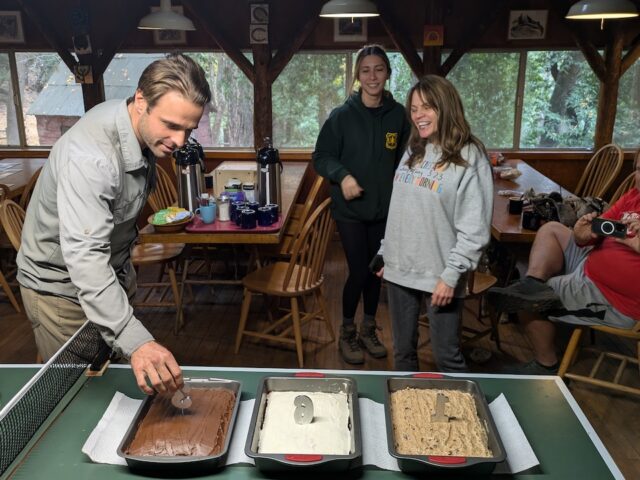
Plus Twenty Candles
Not one but THREE tasty cakes + frosting were enjoyed by various partying hikers to celebrate Wilbur Sturtevant’s birthday on Nov. 23rd And to prove that the years DO matter, many pointed out the birthday math error; it wasn’t his 163rd, but 183rd birthday! Wilbur was quoted as saying, “C’mon, after 150, what’s a decade or two, give or take a few?”
2025 Preview
January: opening the Camp to overnight guests, and the Conservancy’s annual meeting.
Mid-Winter: what will the weather bring?
Spring: a new slate of special events at Camp featuring food, music, crafts, and ?
Summer: fair warning – revised Lodging rates.

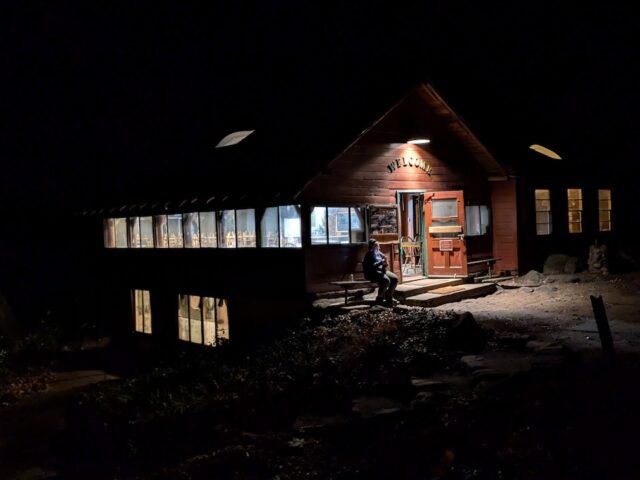
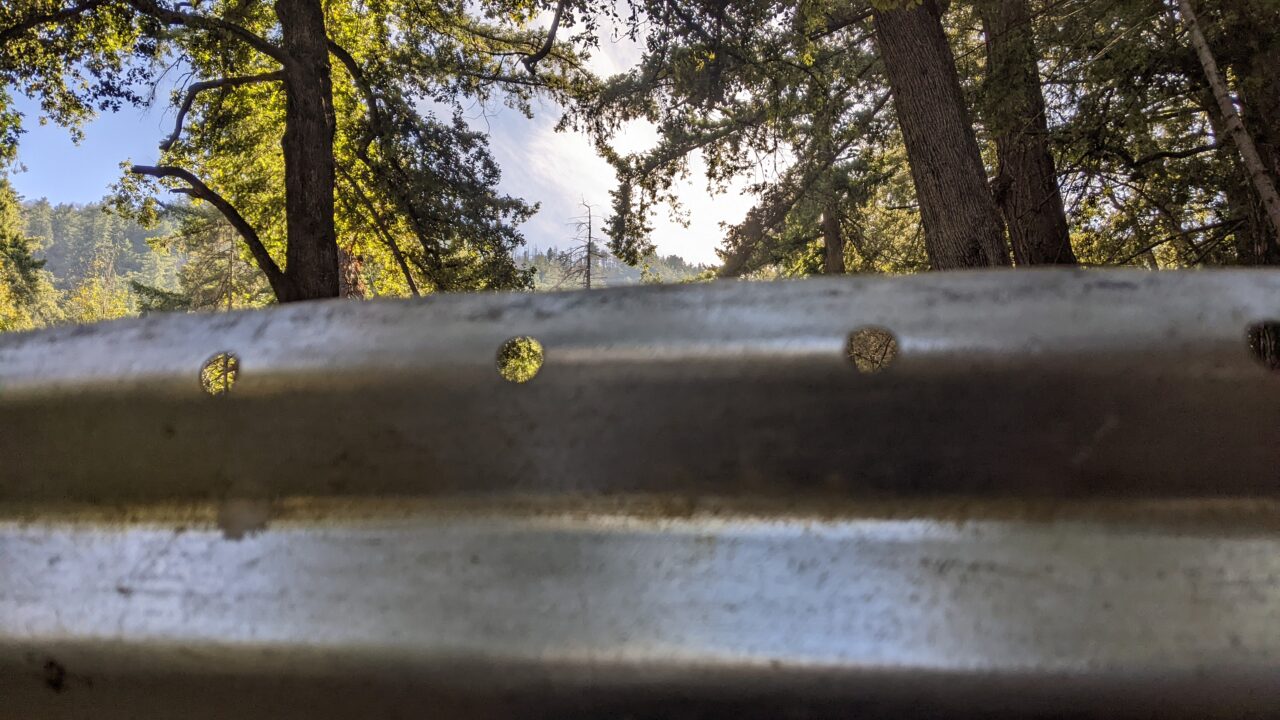
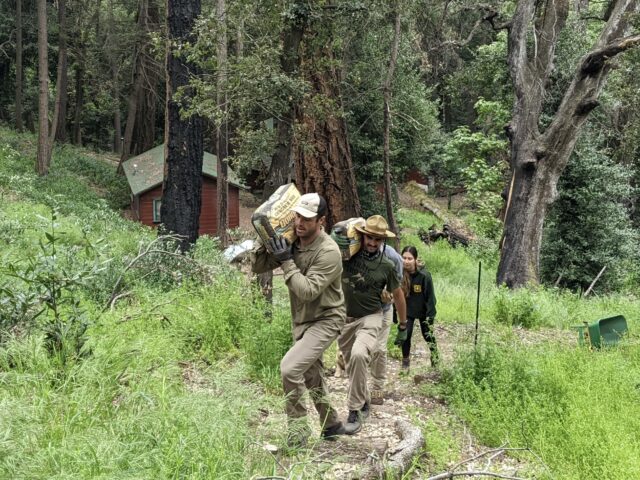
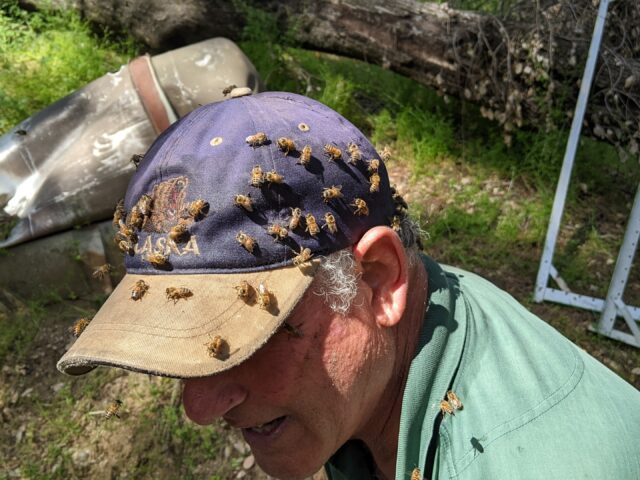


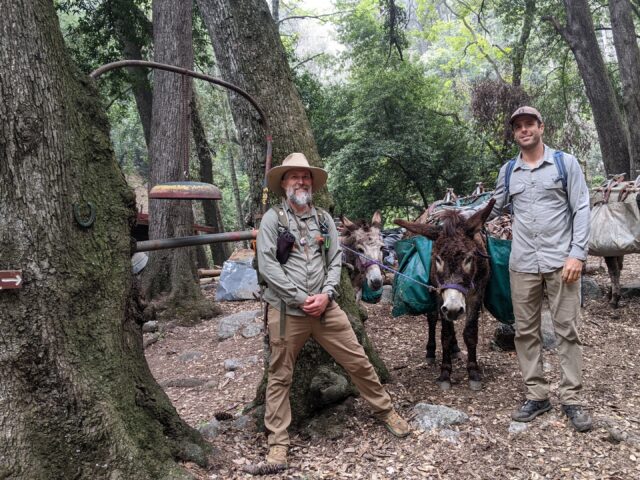
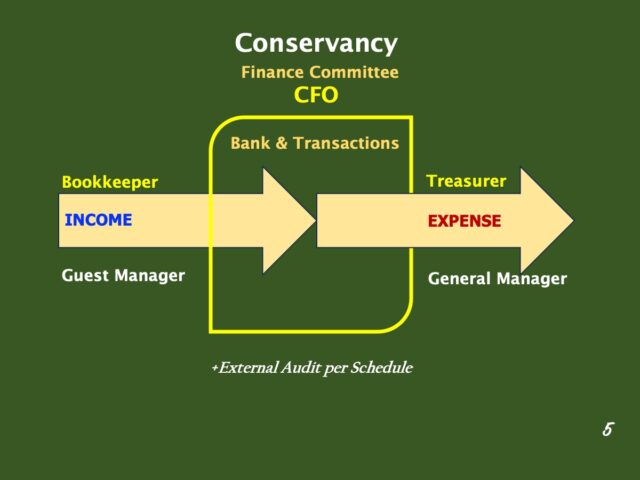

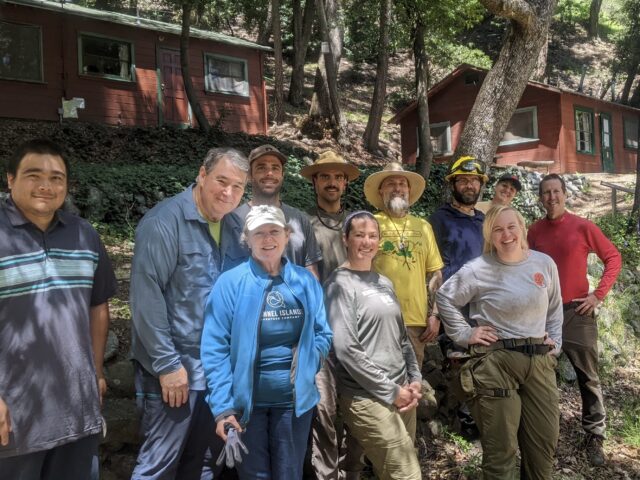
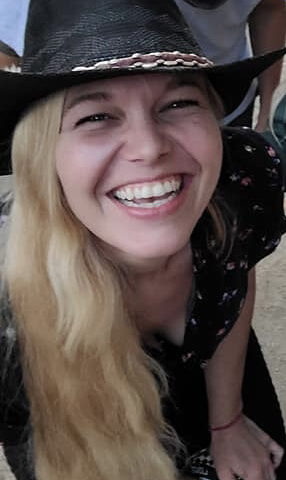
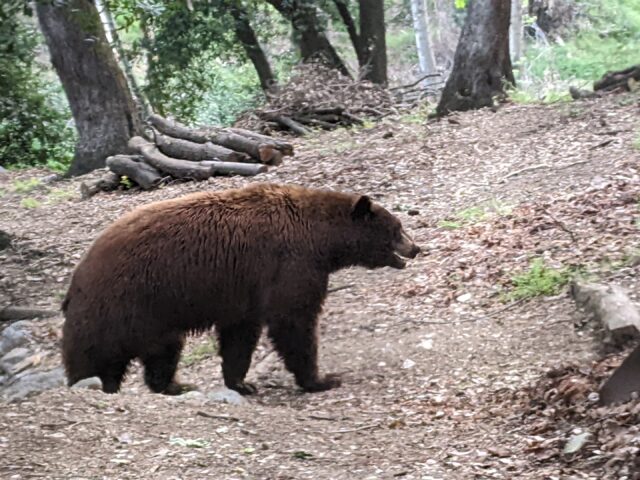
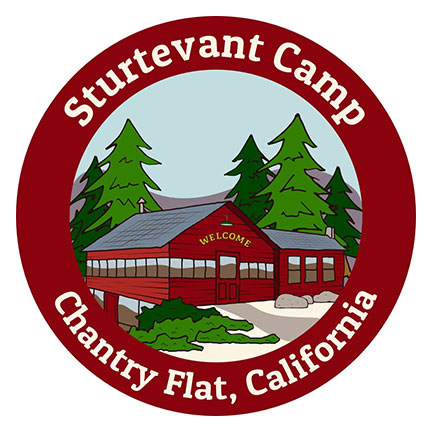
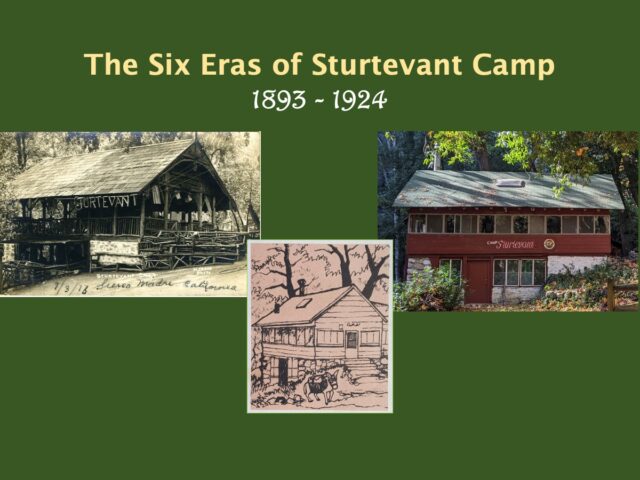
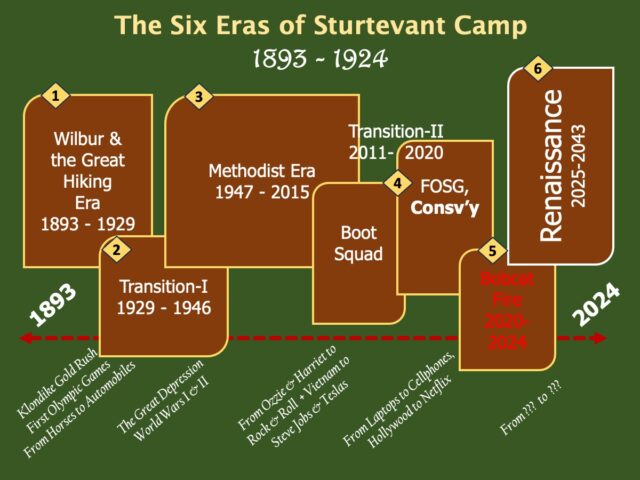
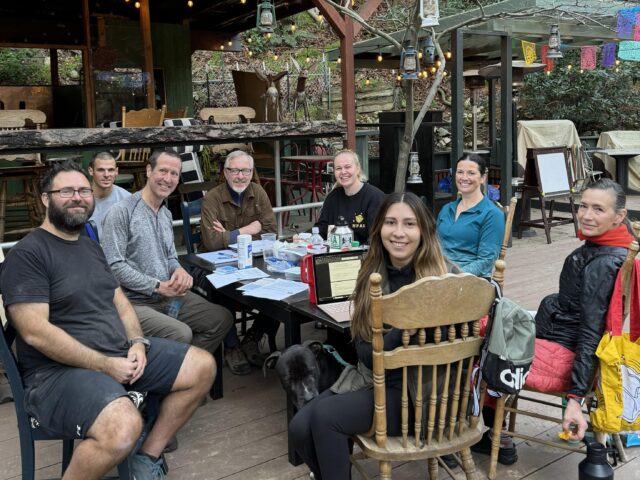
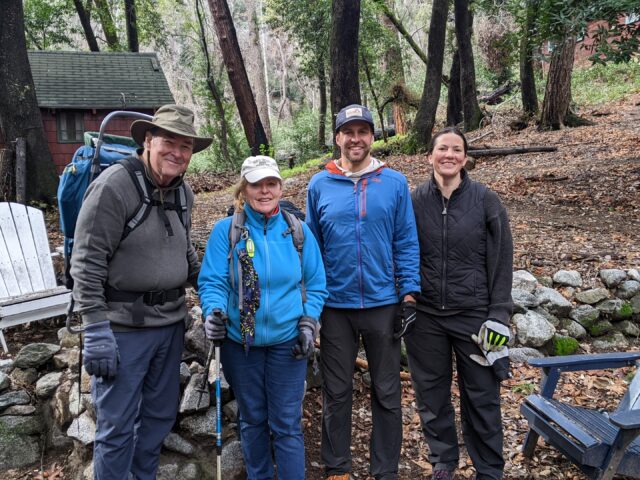
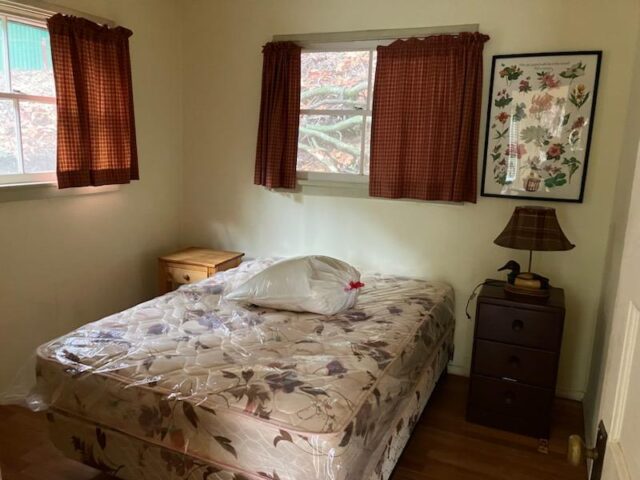
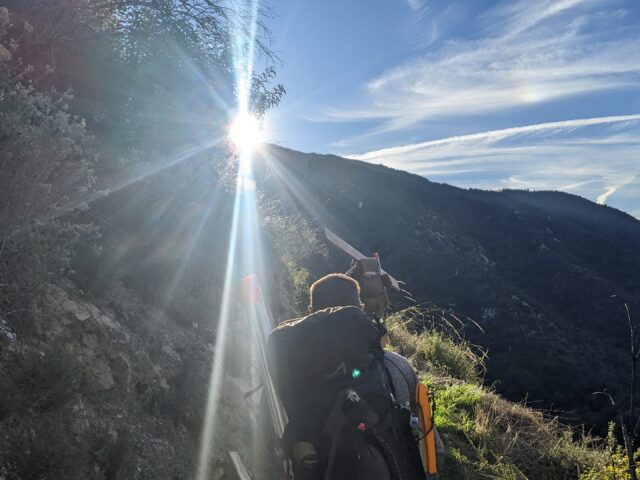
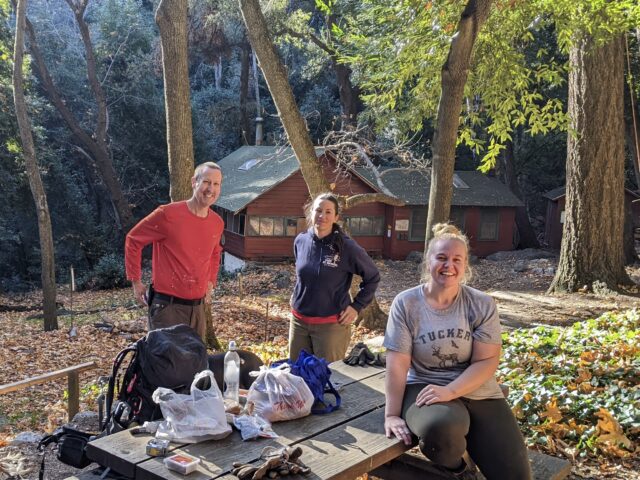
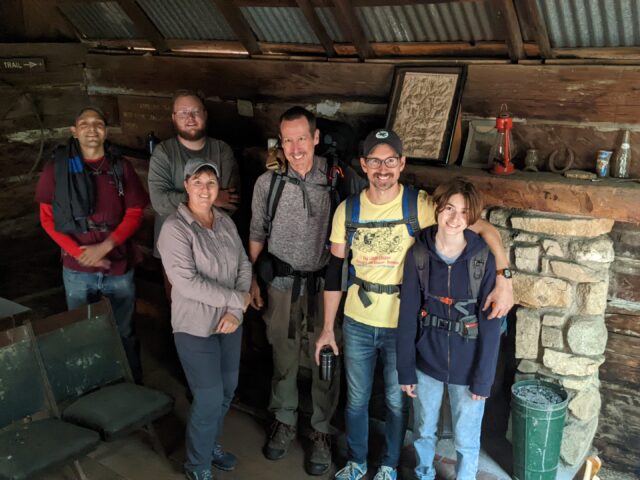
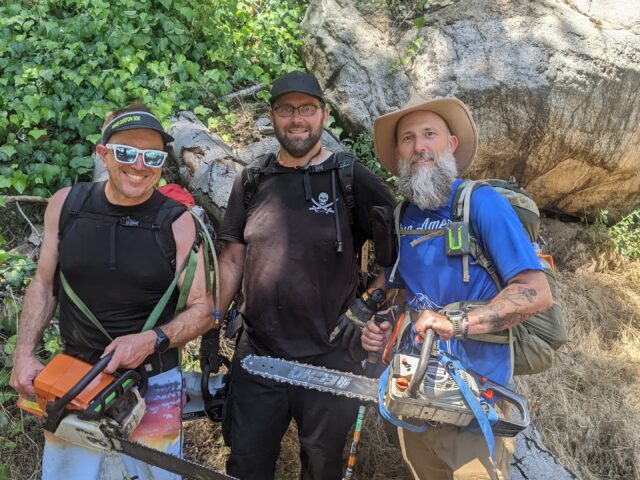
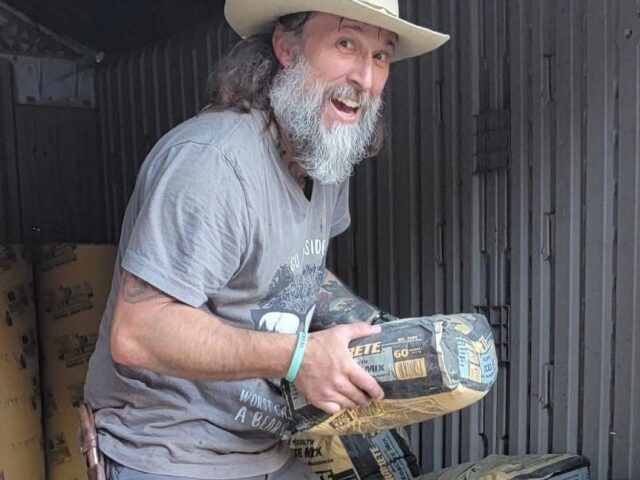
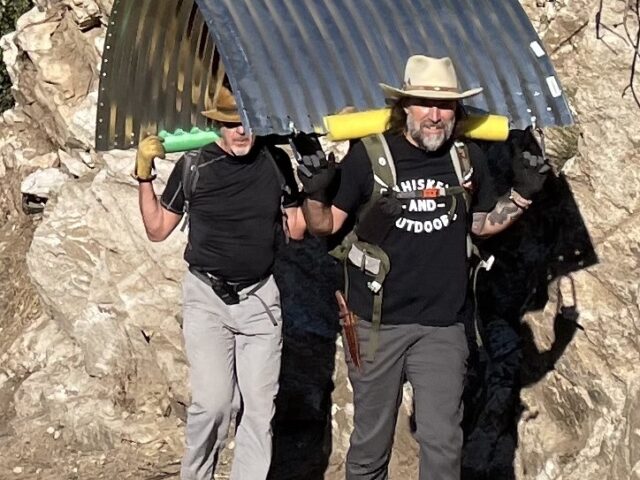
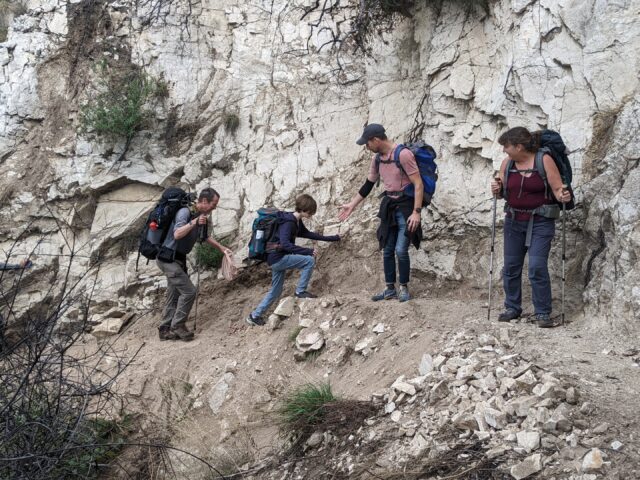
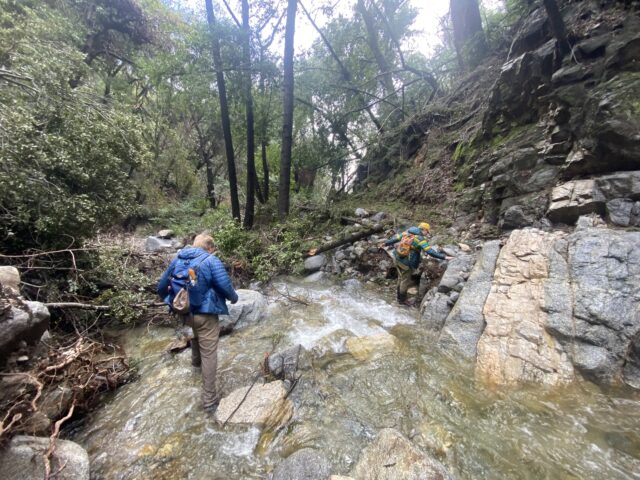
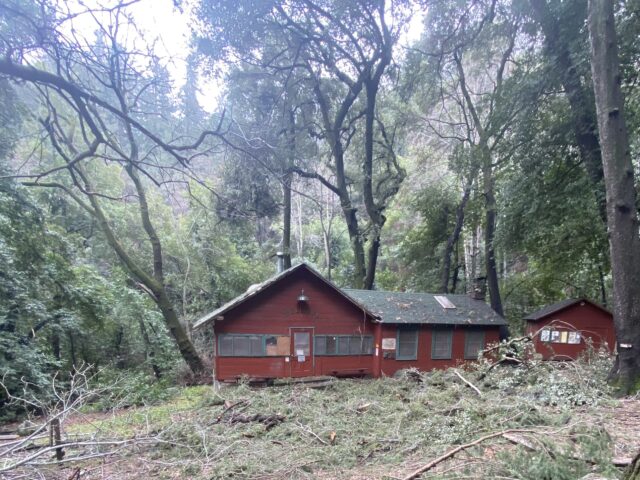
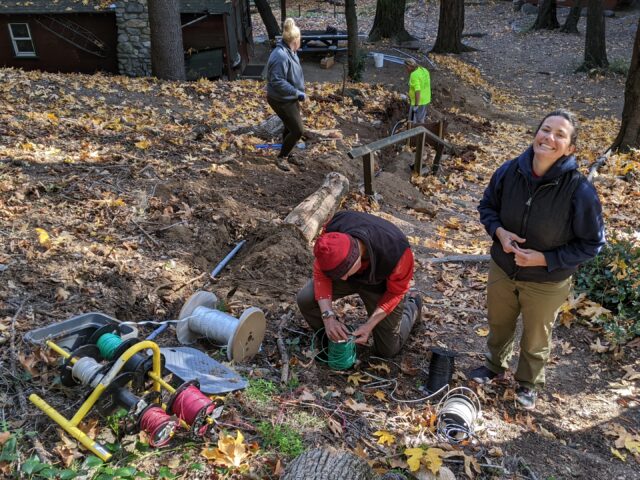
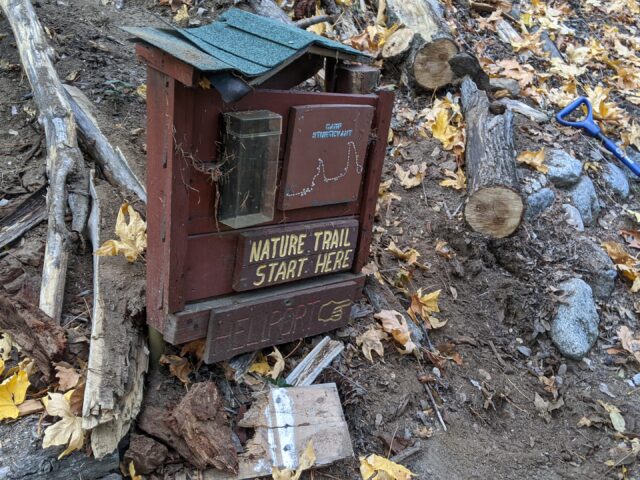
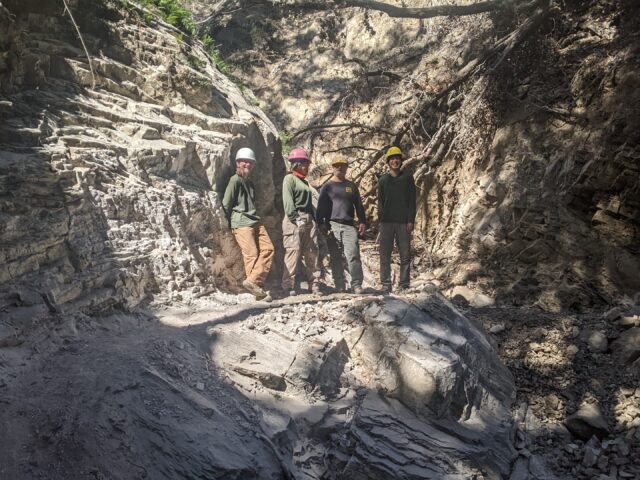
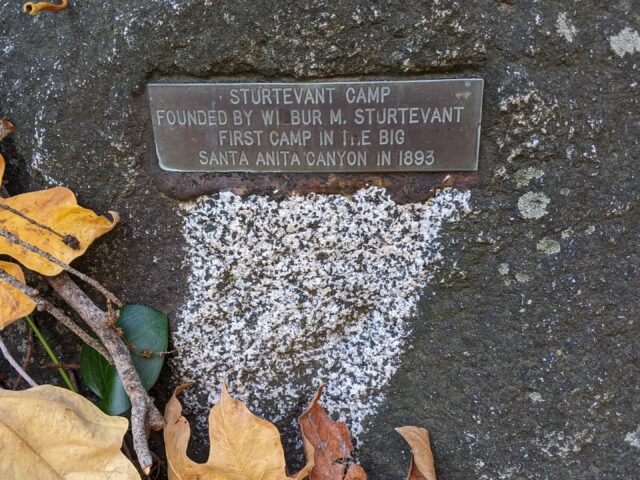
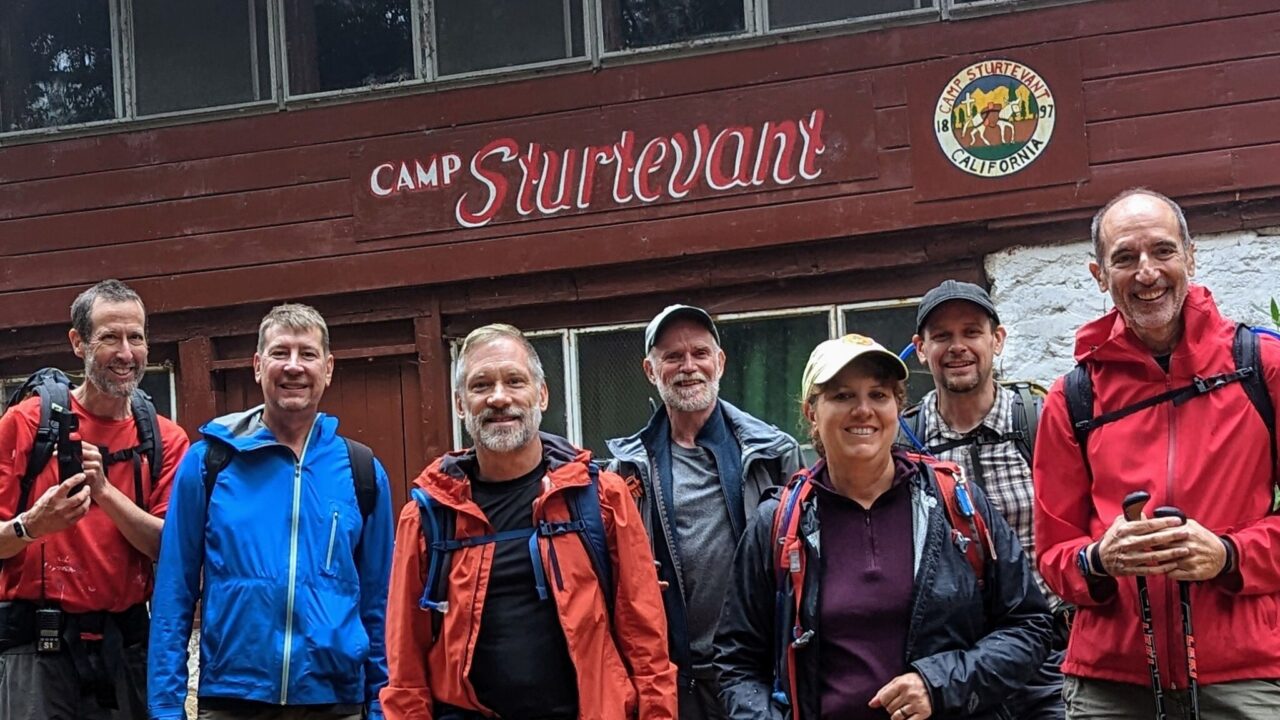
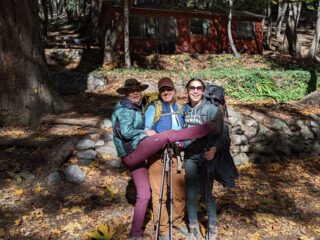
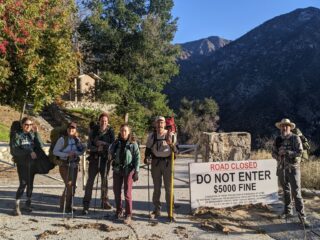
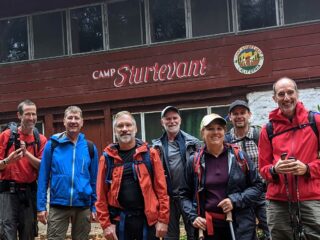
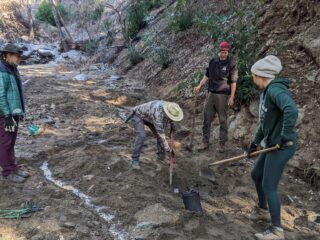
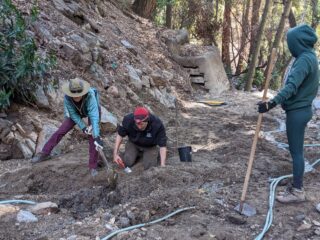
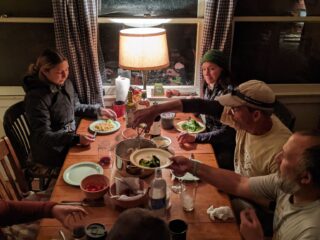
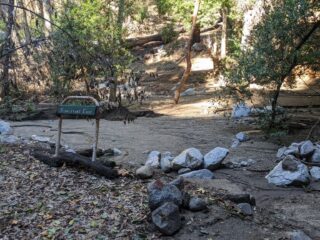
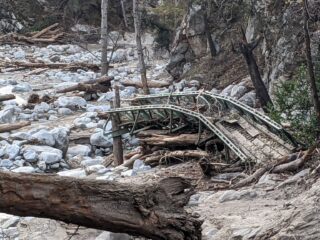
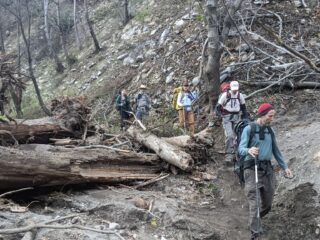
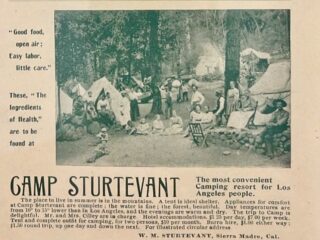
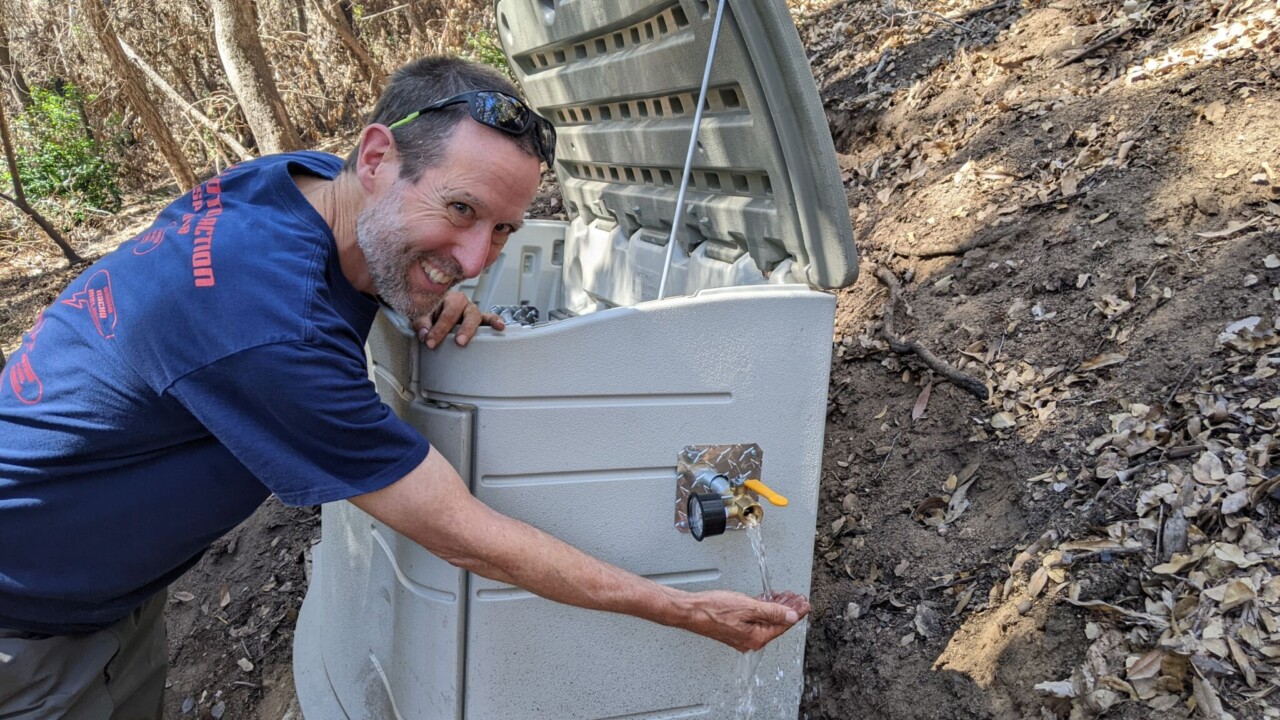
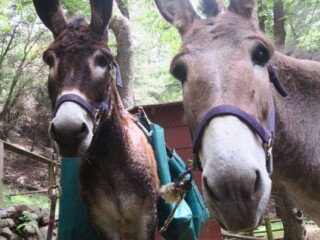


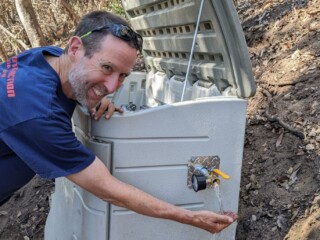
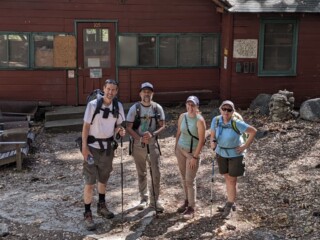
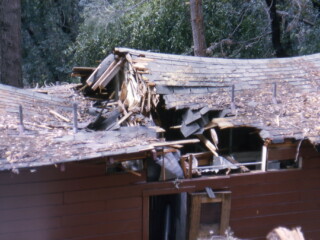
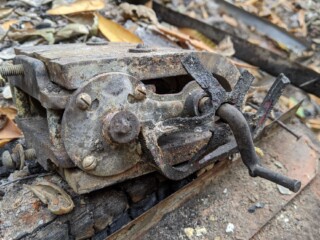
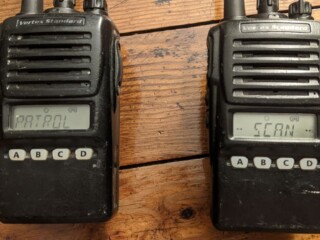
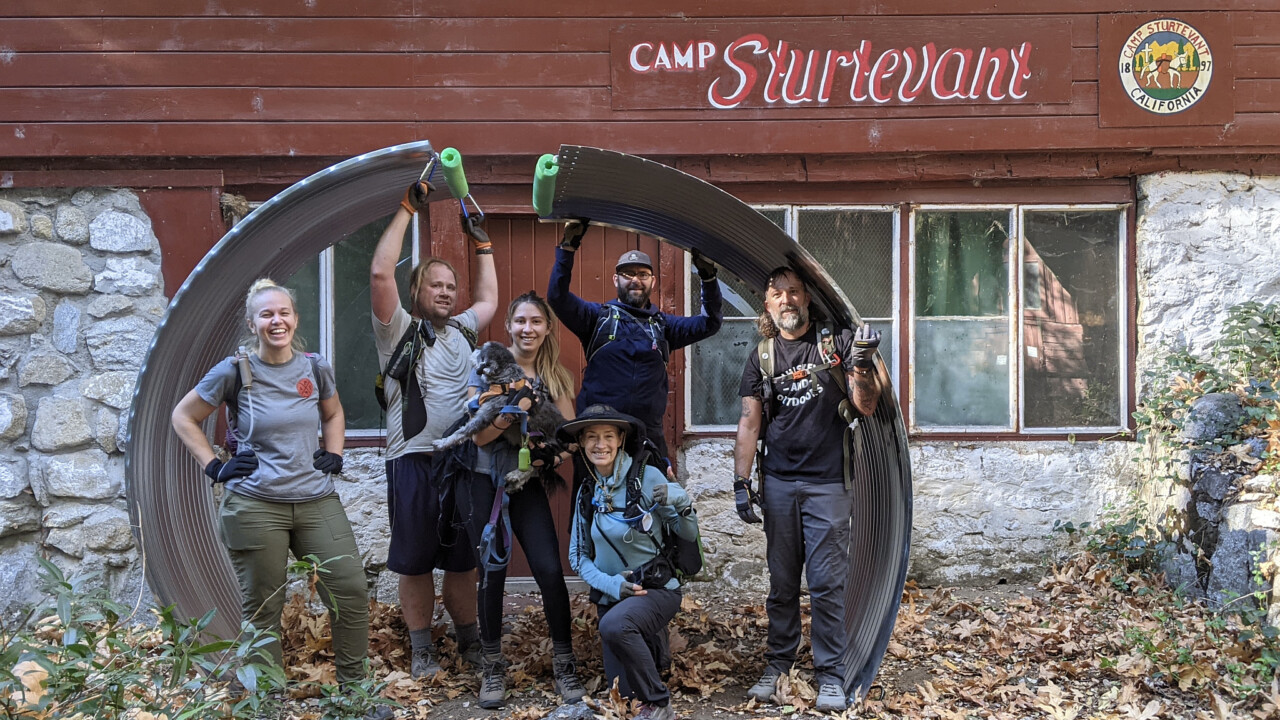
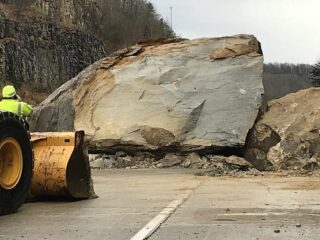 The Chantry Road has experienced a lot of drama over the years, but the upcoming closure* for repair/reconstruction will introduce something new. Previous repairs have been one of two types: bulldozing debris avalanches off the road, or when the road washes out, rebuilding the base and pouring new pavement.
The Chantry Road has experienced a lot of drama over the years, but the upcoming closure* for repair/reconstruction will introduce something new. Previous repairs have been one of two types: bulldozing debris avalanches off the road, or when the road washes out, rebuilding the base and pouring new pavement.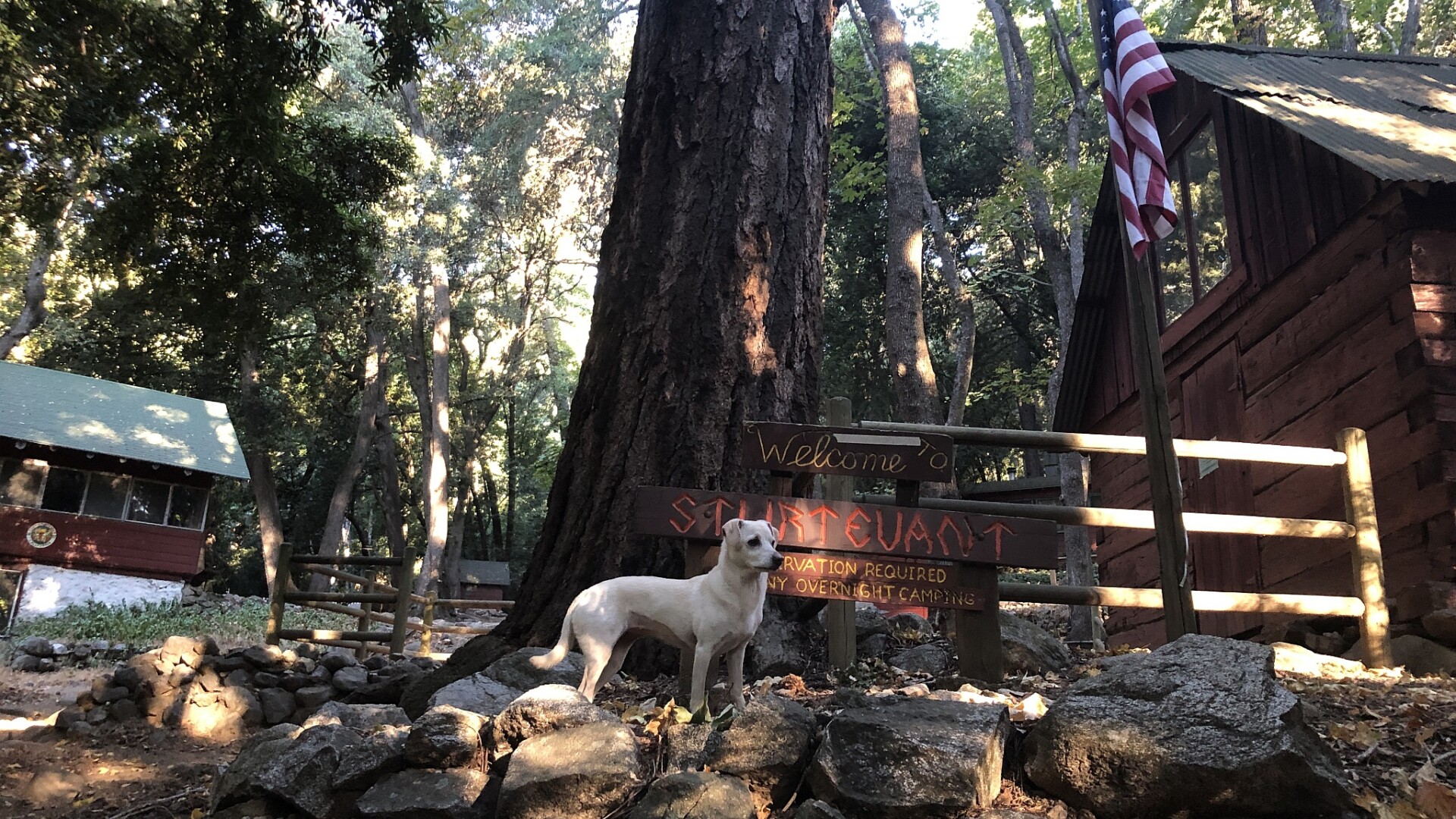
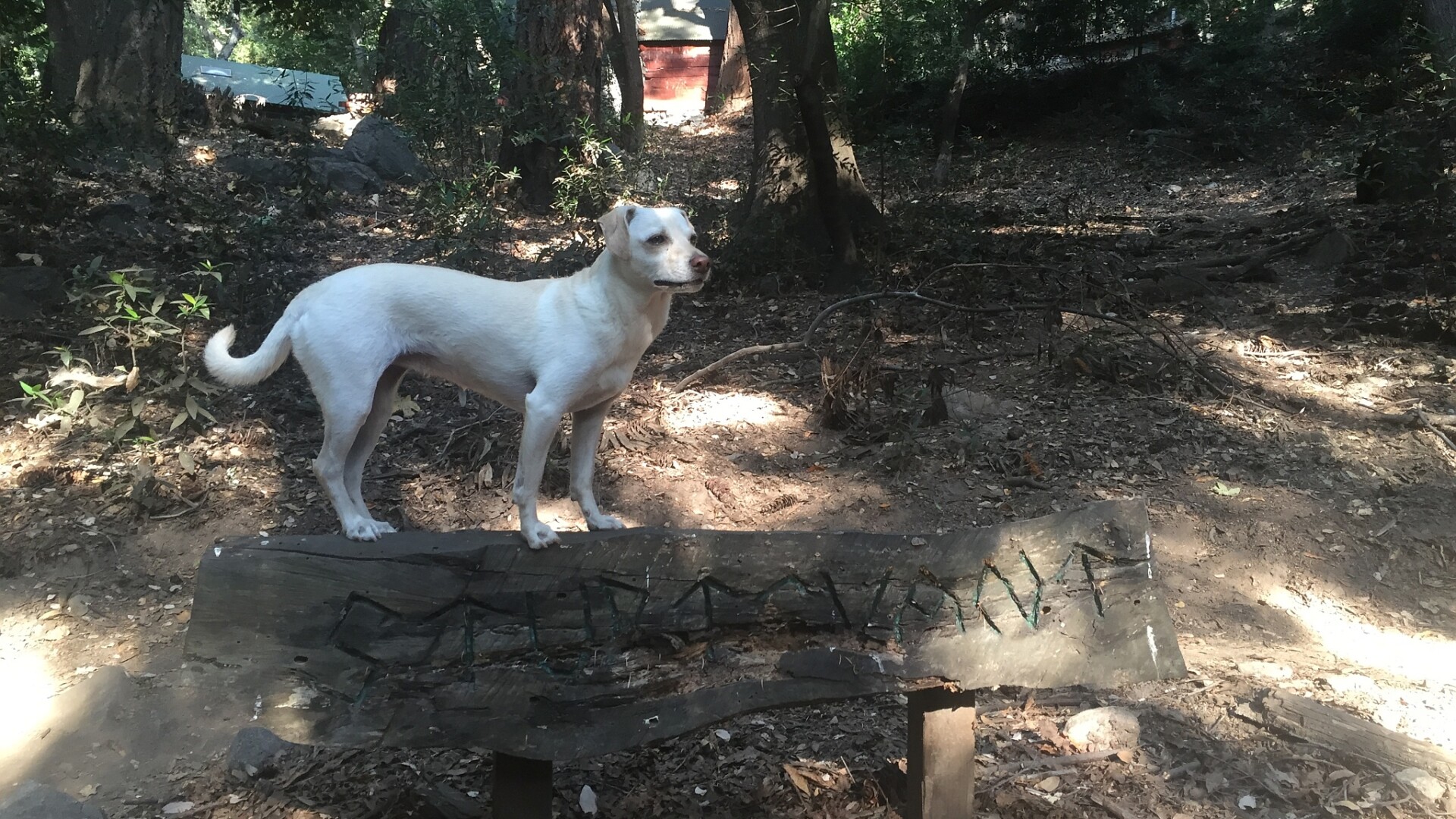
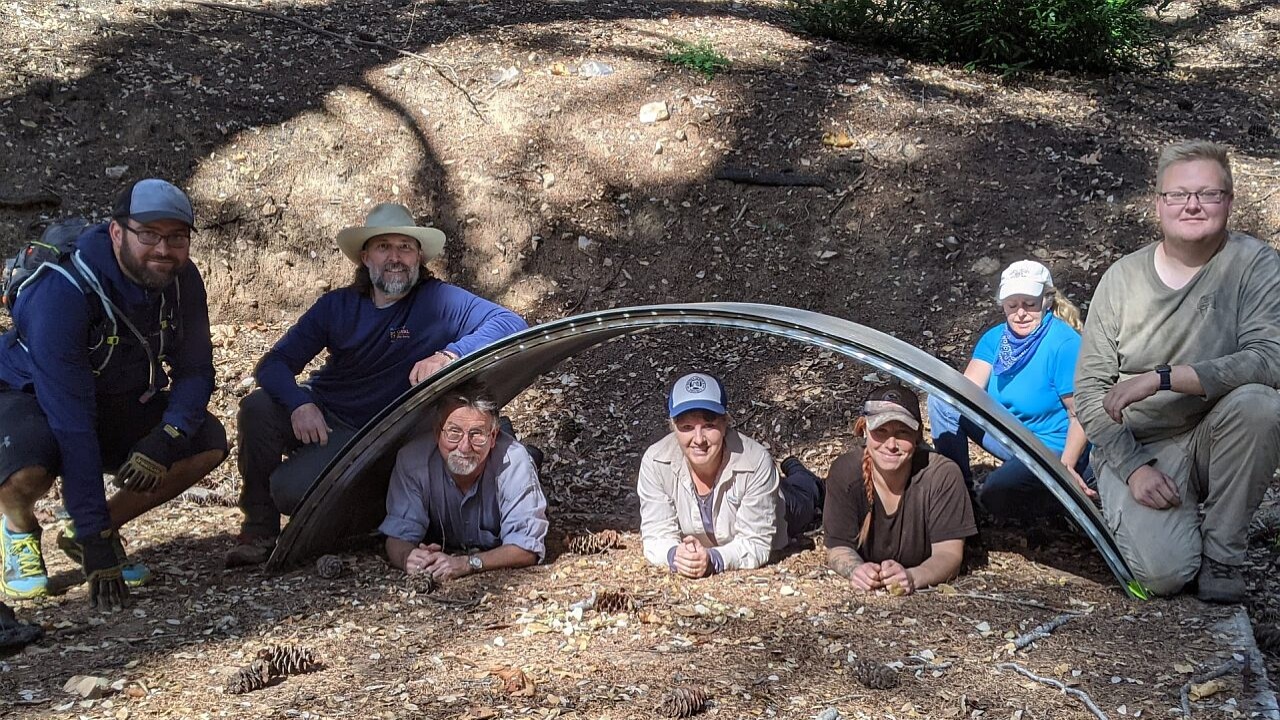
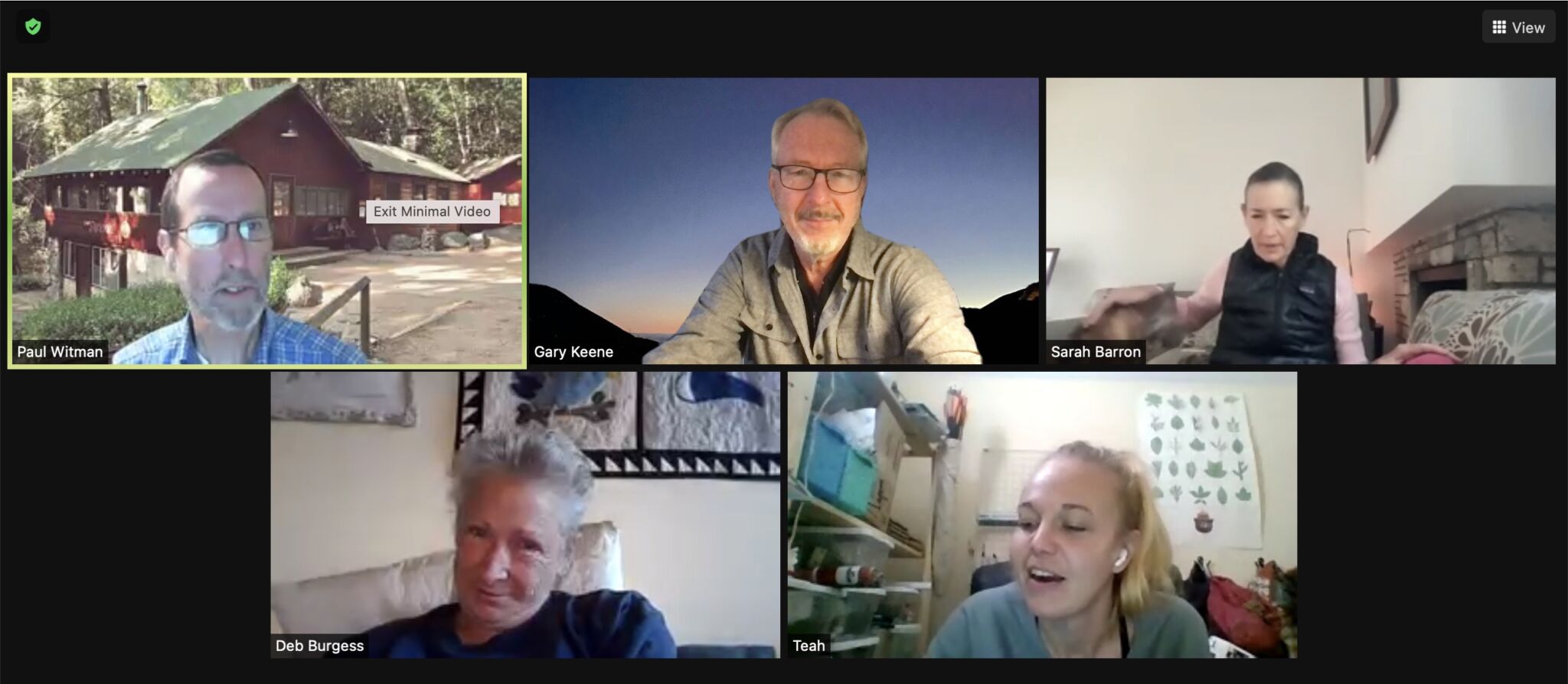
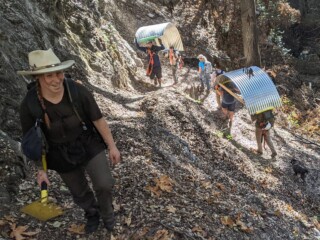 We had the parts, the people and a plan—then if finally rained for real in the San Gabriels! The first run to deliver a water tank panel up to camp was delayed so that the trail could get worked back into shape (mostly). Plenty of shovels and shoulders were duly exercised!
We had the parts, the people and a plan—then if finally rained for real in the San Gabriels! The first run to deliver a water tank panel up to camp was delayed so that the trail could get worked back into shape (mostly). Plenty of shovels and shoulders were duly exercised!